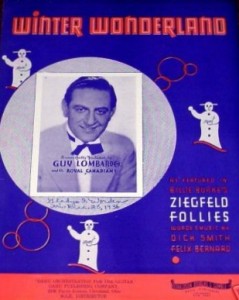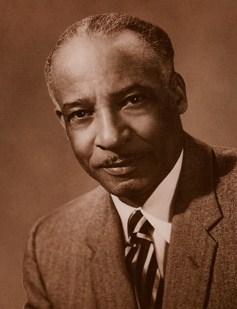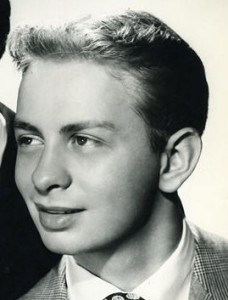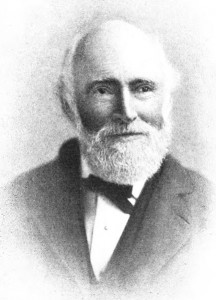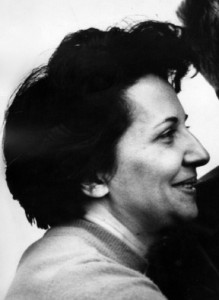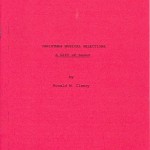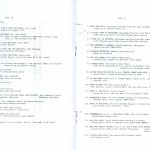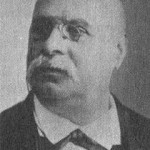Christmas Classics PERSON OF THE DAY: James Kimball Gannon
On this day in 1900, James Kimball Gannon was born in Brooklyn, New York. Better known as Kim Gannon, he was an American songwriter and lyricist for the perennial Christmas favorite I’ll Be Home for Christmas.
Gannon attended St. Lawrence University and as a senior wrote the school’s alma mater song The Scarlet and the Brown. A proud graduate of St. Lawrence in 1924, he had every intention of becoming a lawyer. The Great Depression delayed that career pursuit and in 1930 he was working as a salesman for a utility company. By 1934 he passed the New York state bar examination, but five years later the songwriting bug struck and soon after he composed his first commercial song, For Tonight.
The year 1942 found Gannon writing songs during the “swing era” and for films including the lyrics of the film title song Always in My Heart that earned him an Academy Award nomination for Best Song. He replicated that achievement twice more: 1) Too Much In Love for the film Song of the Open Road in 1944, and 2) Endlessly in 1945 for the film Earl Carroll Vanities. But in between he collaborated with Walter Kent in 1943 to produce I’ll Be Home for Christmas. Gannon also wrote songs for the films Powers Girl and If Winter Comes before Broadway beckoned in 1951 when he teamed up with Walter Kent again on the score for Seventeen.
Despite his success with film and Broadway, Gannon is best remembered for his popular and wistful Christmas lyric I’ll Be Home for Christmas. First recorded by Bing Crosby in 1943, it has since been recorded more than three hundred times and is an important part of American Christmas Classics.
The amiable Kim Gannon, who died in 1974, was always true to his alma mater. In his will he stipulated that after his wife Norma’s passing (she died in 2006), 30% of all royalty proceeds from his songs were to go to St. Lawrence University. The majority of those royalties, you can bet, come from his 39-word holiday classic I’ll Be Home for Christmas.
Christmas Classics PERSON OF THE DAY: Richard B. Smith
On this day in 1901, the little known Richard B. Smith was born in Honesdale, Pennsylvania. He was the lyricist (Felix Bernard wrote the music) of the popular Christmas song Winter Wonderland that was first recorded by Guy Lombardo in 1934. Unfortunately for Smith, who was diagnosed with tuberculosis in 1931, he never got to enjoy the success that came to his classic song after succumbing to the disease in 1935, thus aborting what looked to be a promising career.
Smith had attended Penn State University, majored in advertising, and was responsible for editing the school magazine. His interest in music was also on display there when he formed and conducted his own orchestra. After graduating from Penn State, Smith moved to New York and began a career as a newspaper editor. The music bug, however, never left him as he took on the management of several Broadway theaters.
The Pennsylvania lyricist got married in 1931. Shortly after the happy event he was stricken with the dreaded tuberculosis and soon was admitted to the West Mountain Sanatorium where his wife was a nurse. With his wife near to his side, Smith’s talent for songwriting blossomed as he produced When A Gypsy Makes a Violin Cry, Bringing My Honey Back to Me, and the popular Winter Wonderland while convalescing, all of which caused Hollywood to come knocking. Before long Smith gladly agreed to a contract to write music for films; but a month before he was to go to California he passed away.
The inspiration for Winter Wonderland, a delightful addition to American Christmas Classics supposedly came from familiar winter snow scenes Smith remembered from life near the Pocono Mountains. Eight years after his passing, his song made it to the top of the charts and it has since become a perennial favorite during the Christmas season.
Christmas Classics PERSON OF THE DAY: William L. Dawson
On this day in 1898, William Levi Dawson was born in Anniston, Alabama. He was an acclaimed African-American composer, conductor, and trombonist who wrote a wonderful arrangement of the Christmas spiritual Mary Had a Baby, a carol with two distinct lyrical texts. In some circles Dawson was called the “father of the Negro spiritual” although such a sobriquet might be contested by the John Works family also noted for its scholarship of Negro folk music.
Dawson was determined to earn a music education. Although black students were prohibited from attending classes, several professors helped him to clandestinely pursued his bachelor degree at night from the Horner Institute of Fine Arts in Kansas City. By day he taught at the city’s Lincoln High School. His formal studies continued at the Chicago Musical College and the American Conservatory of Music, the latter from which he earned his master degree. He also enjoyed a career as a trombonist for both the Civic Orchestra of Chicago and Redpath Chautauqua, a campground assembly that usually gathered during the summer for music events or literary, moral, and scientific lectures.
The composer’s career, however, was primarily devoted to teaching at the college level. In 1931 he went to teach at Tuskegee University in Alabama where he soon himself the founding chairperson of its School of Music. During his tenure at Tuskegee, ending in 1956, Dawson achieved greatness as a composer. His body of work included arrangements and variations of spirituals, including his popular Ezekiel Saw the Wheel, King Jesus is a-Listening, and Jesus Walked the Lonesome Valley, and other spirituals that are widely published and regularly performed by school and community choral programs. In the classical realm, he is best known for Negro Folk Symphony, reputedly the first of its kind by a black composer, which premiered in 1934 with the Philadelphia Orchestra under the direction of the dynamic Leopold Stokowski.
The lyrical text of Mary Had a Baby may date from the 18th century when it was probably sung at religious revival camp meetings where a “call and response” technique was utilized to unify the congregation in worship. After the Civil War, this musical style became more prevalent in black churches, especially those of the rural South, whose members learned it from their ancestors, almost all of whom were slaves.
As with most of his arrangements, Dawson employed black folk song idioms to Mary Had a Baby, an important addition to AMERICAN CHRISTMAS CLASSICS . Inspired by the spiritual text, he creates a heightened sense of dignity, despite the humble manger setting, of Mary the mother giving birth to her baby who is richly exalted as “King Jesus.”
Christmas Classics PERSON OF THE DAY: Mel Tormé
On this day in 1925, Melvin Howard Torma, better known as Mel Tormé, was born in Chicago to a Russian Jewish family. He was an accomplished and well-liked jazz composer, scat singer, author, and actor for television and movies. In Christmas music circles he is best known as co-author, along with Robert Wells, of The Christmas Song (a.k.a. Chestnuts Roasting on an Open Fire).
During the World War II years Tormé moved to California, enlisted in the Army, and started his own quintet Mel Tormé & the Mel-Tones. B y 1947 he decided to strike out on his own and then went on to develop a reputation as a cool jazz singer. He did not disappoint in 1948 with Careless Arms, a number one hit. In all “The Velvet Fog” a sobriquet Tormé detested, is credited with 250 songs and the arranger for a host of songs he sang for several recording companies, including Decca and Capitol Records. For a time in the 1960s he was the principal song writer and music arranger for The Judy Garland Show and by the 1970s with the resurgence of jazz singing his career was revitalized and from that time forward he remained a presence in the jazz world until his death.
How Tormé became associated with one of the most popular Christmas songs for the past seven decades is one for the books. During a terrific heat wave besieging Los Angeles in July of 1945, the songwriter Robert Wells sat at his piano and tried to find solace from the heat by jotting down several lines of lyrics with wintry themes. “It was so damn hot, I thought I’d write something to cool myself off,” he once said. “All I could think of was Christmas and cold weather.” While in this mood, his good friend Mel Tormé paid a visit. When Tormé noticed the notes Wells had put to paper, he suggested to him that they just might have the beginnings of a Christmas song.
Within twenty or forty-five minutes, depending upon who’s telling the story, the two songsters produced The Christmas Song. Tormé then went to the home of Nat King Cole and convinced him to record the song, and in the Spring of 1946 Nat went into a New York recording studio with a simple piano version of the song. The initial results weren’t satisfactory, and at the urging of his wife Maria and manager, the mellifluous singer responded with a more highly regarded version with strings and full orchestra. It was Cole’s exquisite recording that popularized the song, and over the years The Christmas Song has consistently ranked as one of America’s seasonal favorites.
Considered an historic recording, the song was honored in 1999, as was Tormé himself for life time achievement, by being inducted by the Grammy Awards organization into its Hall of Fame.
The Christmas Song has truly stood the test of time. This is quite understandable because it was written during an age when composers like Tormé produced music marked by grace and charm. In retrospect it is easily understood why his passing was mourned by many, especially by those nostalgic for such memorable musings from “Chestnuts roasting on an open fire” . . . to . . . “And so I’m offering this simple phrase, To kids from one to ninety-two; Although it’s been said many times, many ways, “Merry Christmas to you.”
Christmas Classics PERSON OF THE DAY: John Sullivan Dwight
On this date in 1893, John Sullivan Dwight died in Boston. He was one of the more compelling figures from Harvard University who were Christmas carol composers or translators. They included among others, Edmund Hamilton Sears (It Came upon the Midnight Clear), Henry Wadsworth Longfellow (I Heard the Bells on Christmas Day), and Rev. Phillips Brooks (O Little Town of Bethlehem). Dwight’s contribution was providing the English translation for O Holy Night after the French carol Cantique de Noël.
After graduating from Harvard Divinity School, John Sullivan Dwight served as a Unitarian minister in Northampton, Massachusetts. But his stay there was short-lived. He had to leave the ministry because he became deathly ill when he had to deliver sermons to his congregation. After leaving the ministry he became a recluse and then sojourned to the socialistic Brook Farm community, of which he was one of its founders. For five years there he lived a transcendental life teaching classical languages and music. Life on the commune also meant time for farming, cutting wood, cultivating trees, and other chores.
Eventually he returned to Boston and devoted himself to literature where he became America’s first influential classical music critic writing for Dwight’s Journal of Music. For several years it was the only musical journal in the country.
Dwight also cultivated an interest in European carol tunes, particularly the French carol Cantique de Noël (a.k.a. Minuit Chrétiens). A carol with an intriguing history, it became much disliked by French church authorities even though it had originally been well received by them and the church faithful. This turnabout led to criticism about the carol’s perceived lack of musical taste and because it did not possess the “spirit of religion.” But the repudiation of the carol may have been due to Placide Cappeau, the carol lyricist, and his socialist leanings and later renunciation of Christianity; not to mention the fact that Adolphe Adam, the composer of the carol melody, was Jewish.
Thirteen years after Dwight’s death the carol had the distinction of being the first ever heard on the radio. On Christmas Eve in 1906 ships at sea heard O Holy Night being played on a violin.
- John Sullivan Dwight
Christmas Classics PERSON OF THE DAY: Gloria Shayne
On this day ninety years ago, Gloria Adele Shain was born of a Jewish family in Brookline, Massachusetts. She changed her name to Gloria Shayne early in her professional career as a pianist and composer. In the 1940s she moved to New York,and it was there where she made her mark.
In the world of Christmas music she is famed for composing Do You Hear What I Hear? in collaboration with her husband Noel Regney, a Frenchman.
The Shayne and Regney union was a story of romance. They met in the early 1950’s when the Frenchman came to the Beverly Hotel in New York, now known as the Benjamin Hotel, where Shayne was playing the piano. Both were duly smitten on their chance meeting and a month later the two lovers were married.
Do You Hear What I Hear?, although often taken for a Christmas carol, was actually composed by the husband and wife team as a hymn of peace, one borne out of a sense of desperation and fear of war because of the looming Cuban Missile Crisis. Both composers had not forgotten about the horrors of war. During the World War II years Shayne worked for the Jewish Welfare organization at a time when millions of Jews were being slaughtered by the Nazis. Regney, trained as a classical composer, witnessed its terror first hand when he was conscripted by the German Army, even though he was a Frenchman, but soon deserted it to join the French Resistance.
Shayne and Regney were especially fond of the phrase “Pray for peace, people everywhere!” in the carol’s last stanza because it emphasized the rationale for the song. Somehow their hymn of peace became part of the Christmas carol repertoire, perhaps because of Regney’s lyrical imagery of lamb, shepherd boy, and the Child Jesus sleeping that could easily be associated with the Nativity scene.
Shayne and Regney collaborated on a number of famous songs, including Rain, Rain Go Away first performed by Bobby Vinton and Sweet Little Darlin’ first performed by Jo Stafford. But she also enjoyed success on her own, including writing the music and lyrics for Goodbye, Cruel World, recorded by James Darren, and co-writing The Men in My Little Girls’ Life, performed by Mike Douglas, and Almost There that was first sung by Andy Williams.
Gloria Shayne divorced Noel Regney in 1973. She remarried, and in 2008 she died at home in Stamford, Connecticut of lung cancer. She will be most remembered here for her contributions to Do You Hear What I Hear?, a song of peace that eventually spawned a lovely Christmas carol.
Christmas Classics PERSON OF THE DAY: William Hayman Cummings
In August 1831 William Hayman Cummings was born in Sidbury, England. He was a musician, notable tenor, and organist who may be best known for his wedding of Felix Mendelssohn’s music to the Charles Wesley hymn Hark! The Herald Angels Sing. An accomplished musician, Cummings was educated at St. Paul’s Cathedral Choir School and the City of London School. He was also the founder of the Purcell Society, a reputable singing professor at the Royal Academy of Music and later a principal for the Guildhall School of Music.
Wesley, who co-founded the Methodist Church, originally titled his hymn as Hark! How All the Welkin Rings in the 1739 publication Hymns and Sacred Poems. The carol melody was adapted from a cantata that Mendelssohn wrote as part of his commission to compose music for the 1840 Leipzig Gutenberg Festival. That festival commemorated the 400th anniversary of the invention of the printing press by Johann Gutenberg. Six years later the teenage Cummings was a chorister for Mendelssohn’s first London performance of Elijah, the second of three oratorios composed by the German master.
Perhaps during that performance Cummings developed an admiration for Mendelssohn’s music and then in 1855 decided to link Mendelssohn’s music with Charles Wesley’s hymn. Thus on Christmas Day of that year, Hark! The Herald Angels Sing was first sung at Waltham Abbey with William Hayman Cummings at the organ.
Christmas Classics PERSON OF THE DAY: Edward Bliss Reed
On this day in 1872, Edward Bliss Reed was born in New York.He was an esteemed professor at Yale University as well as eminent translator and propagator of Christmas carols. From 1924 to 1947, primarily during Reed’s editorial stewardship, the Carol Society of New Haven, Connecticut published nineteen high quality carol collections. Most collections contained eight carols from European countries, some of which were relatively unknown and theretofore unpublished. Although only a limited number of volumes were printed, I had the good fortune to find some of them on the well-organized shelves of the University of Pennsylvania Van Pelt Library.
The Yale scholar engaged himself in many literary pursuits during his career, but he seemed particularly motivated by his love of Christmas carols. Besides being a major contributor to the revival of medieval songs of Europe, Reed consistently researched, translated, and published carols, such as Christmas Carols Printed in the Sixteenth Century (1932), in addition to editing the collections of the Carol Society.
For most years from 1913 until his death in 1940, Reed took great delight in arranging the annual Phi Beta Kappa Christmas carols concerts at Yale’s Battell Chapel. His passing, though predating the last of the Carol Society publications, was a great loss and for all extensive purposes led to the Carol Society closing its door.
Christmas 1988 Starts Me on the Yellow Brick Road
In 1988 I thought it would be a neat idea to share the riches of my Christmas music collection. So for Christmas I gift-wrapped four audio cassettes of the finest recordings from my collection and gave them to family and friends. Each gift collection was accompanied by an 8-page type-written directory with a Chinese red cover titled “A Gift of Sound.” Besides having a decorative, though primitive look, the directory of song titles was intended to be easier on the eyes than my barely legible long-hand. Just imagine writing the same information on cassette index cards four times twelve, or forty-eight total! The thought was enough to give me writer’s cramps. My quaint IBM Selectric II typewriter, however, saved me the trouble and as a result the directory included not only selection titles, but also brief liner notes that sometimes indicated the origin of each carol, holiday song, or instrumental piece.
Some of my friends included those of the Jewish faith married to Christian partners. They admitted that although they usually felt left out at Christmas, they were indeed appreciative of my eclectic Christmas music gift. What made the collection special for most was the quality of the music. Quite unlike what they were accustomed to hearing during the holidays, it encompassed Gregorian chant, once the Christmas music of its day, and such classical pieces as "Anima Nostra,” Bach’s “Christmas Oratorio,” the German motet ""Hort zu lieben Leute," and the Spanish villancico, "Riu, Riu, Chiu” just to name a few. The collection was rounded out by lyrical English carols from the 16th and 17th centuries, and better known traditional fare, particularly carol hymns as "O Come, O Come Emmanuel” and “Adeste Fidelis,” or classic holiday songs as “White Christmas,” and “The Christmas Song.” In all, the four cassette collection totaled one hundred and twenty-four titles. Most came from England, France, Germany, and the United States. Entries from Austria, Czechoslovakia, Poland, Italy, and Sweden were also part of the mix. By the end of the 1988 Christmas season I was being encouraged by several friends to do something about my great interest in Christmas music, suggesting that I should pursue my interest and take advantage of my college degree. This I did. And in 1989 I was on my way.
SPECIAL PERSON OF THE DAY – Émile Waldteufel (December 9, 1837 – February 12, 1915)
The composer of Les Patineurs, Op. 183, Émile Waldteufel died in Paris and is buried at Cimetière du Père Lachaise there. The composer was born in Strasbourg, France to a Jewish Alsatian family of musicians. In 1882 he composed the best-known waltz of his career – Les Patineurs (a.k.a. "The Skaters’ Waltz" in English). Inspired by the Cercle des Patineurs, or "’Rink of Skaters’ at the Bois de Boulogne in Paris, the waltz has since been played in various venues, from concert halls to movies such as The Hollywood Revue of 1929 and Chariots of Fire, to music games like Gamecube’s “’Dance Dance Revolution Mario Mix” and Arc System Works’ “Princess on Ice.”
Waldteufel’s famous waltz evokes wonderful imagery: a poised skater gracefully gliding along the ice and swirling about a ring of other skaters as part of the wintry atmosphere. The delightful music includes the sound of bells that adds a nice touch to the outdoor scene. The noted conductor Arturo Toscanini led the NBC Symphony Orchestra on January 28, 1945, at Carnegie Hall, New York, in a fine RCA Victor recording of Les Patineurs
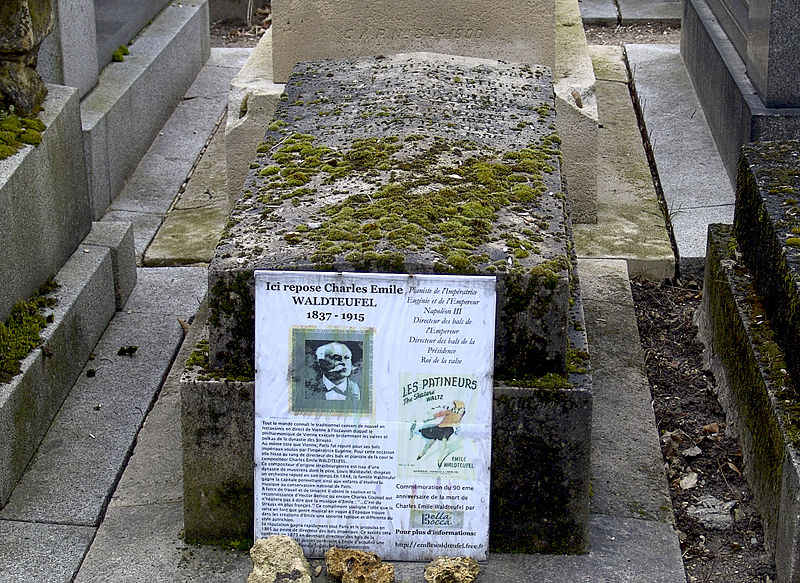
Grave of Émile Waldteufel

